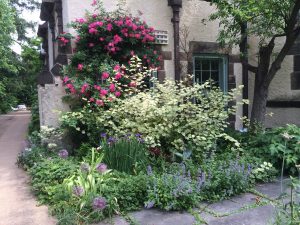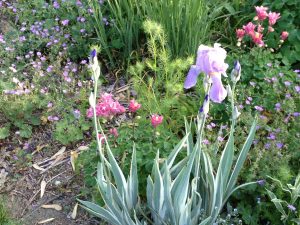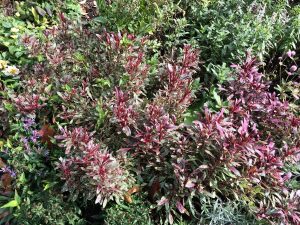
Plant Delights 1998 catalog, one of my favorite mail order catalogs
The catalogs are starting to weigh down my mail lady so I know it’s time to really start thinking about what I want to add to the garden. The biggest dilemma is always finding a space.
So today, I am continuing the discussion on jazzing up the garden by featuring perennials with variegated foliage for sun.

Heliopsis ‘Loraine Sunshine’-pinterest.com
I’m going to start with Heliopsis ‘Loraine Sunshine’. Hardy to zone 3, it is a compact, clump-forming, upright perennial. Typically growing two to three feet tall, it is most noted for its variegated foliage that is very white with green veins. This perennial does have single, daisy-like, yellow flowers above stiff stems that seldom need staking and bloom from mid-summer until frost. However, even though the flowers don’t start blooming until mid-July, the striking variegation attracts the eye early in the season. Although drought tolerant, this False Sunflower will repeat bloom more often if given regular watering. I would place it in the middle or front of a border so that the lovely foliage is visible.

Fallopia japonica ‘Variegata’ with roses in sun in my front garden in June

Fallopia japonica ‘Variegata’ in bloom in my garden but shaded now in late September
Fallopia japonica ‘Variegata’ (Variegated Japanese Fleece Flower) will actually thrive and keep its variegation in either sun or shade. What will be different is the color of the variegation. In sun, the background color of the foliage is bright white but in partial shade it is cream. In either situation, the leaf is stippled with green and pink. Like all knotweeds, this one is rhizomatous and the rate of spread depends on the moisture level of the soil. I have some in dry shade in my fence bed where it has barely moved. I have more in my moist front bed where I have to edit. Hardy to zone 4, this perennial wants to grow six feet tall so it is best used at the back of a bed. In mid to late October, sprays of white (the fleece) appear.

Iris pallida ‘Variegata’ in bloom in my garden in late May

Iris pallida ‘Variegata’ with Arctotis ‘Flame’, Kniphofia ‘Little Maid’ at Blooms of Bressingham
On the other hand, I would plant Iris pallida ‘Variegata’ (Dalmatian Vareigated Iris), hardy to zone 4, at the front of a border. Its grey-green and white variegated leaves are quite wide but short, only twelve inches high. The late May/early June flowers are pale lavender but are gone in the blink of an eye. Nevertheless, clumps of this iris really make a statement in the landscape. There is an apartment building near me with some beds in front of it that are left to the mercies of Mother Nature. The clumps of this iris are thriving in spite of neglect. I grow mine in full sun with regular irrigation but the books say that it can be grown in partial shade. One of the most striking uses of this plant I have ever seen was at Blooms of Bressingham in England where it was combined with Kniphofia ‘Little Maid’ and the annual orange Arctotis ‘Flame’.

Gaura ‘Passionate Rainbow’ in client’s garden
Some cultivars of Gaura, sometimes known as Wand Flower, are variegated but the variegation is red and purple rather than green and white. ‘Passionate Rainbow’ is one that I have used in clients’ gardens. Hardy to zone 5, it is quite drought tolerant but will thrive as well in irrigated gardens as long it has excellent drainage. This cultivar only grows twelve inches high but is in bloom from late June until frost. I have never felt the need to deadhead it.
Spring is almost upon us (yes, I know I’m dreaming) and I hope you find this discussion helpful.


2 Comments